Bees, Hornets, Wasp and Yellow Jackets
Extermination Services
Safe, Professional Bees, Hornets, Wasp and Yellow Jackets Extermination Services in Newark, NY
If you’ve noticed bees, hornets, wasps, and yellow jackets around your home or place of business, you may be concerned about an infestation. While many bees are harmless and are actually good for the environment, some can pose a danger to your family, employees, or customers. Hornets, Yellow Jackets, and Wasps all can cause painful stings, and are the most common types of bees you want removed. Unlike bumblebees who die once they sting you, these dangerous stinging insects can sting you multiple times causing some cause for alarm. All Seasons Pest Control provides pest control and bee services to homes and businesses in the Finger Lakes area.
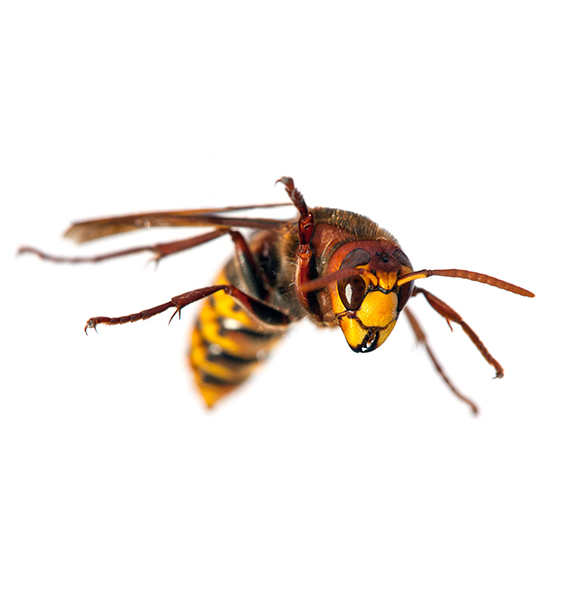
Bee and Wasp Control
Since some bees and wasps can cause structural damage, and some people are severely allergic to them (not to mention their stings are painful!), it’s important to have a professional assess your bee situation to determine if they pose a danger. If removal or eradication is necessary, this is certainly not a “do it yourself” job, and most at-home treatment options will only get rid of some of the bees, so the problem will only grow. Our technicians will inspect your property and create a customized treatment plan based on our findings, and we’ll continue to provide treatment until the problem is solved.
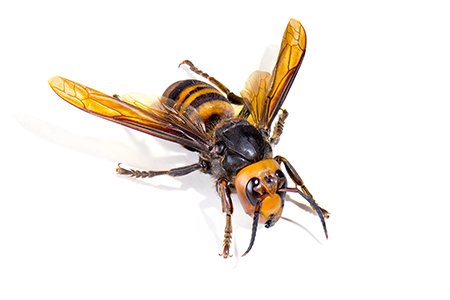
White Faced Hornet
- Adult workers tend to measure around ½ inch in length
- Mostly black and covered in white stripes
- Named for their white faces/heads
- Paper nests tend to be large and tear-shaped and are found either in trees or under horizontal surfaces
- Can emit an attack pheromone that other Bald Faced Hornets of the same nest will sense and also attack
- May sting multiple times and do not die from stinging
- All but the queen live for only one season
White Faced Hornet
-
Adult workers tend to measure around ½ inch in length
-
Mostly black and covered in white stripes
-
Named for their white faces/heads
-
Paper nests tend to be large and tear-shaped and are found either in trees or under horizontal surfaces
-
Can emit an attack pheromone that other Bald Faced Hornets of the same nest will sense and also attack
-
May sting multiple times and do not die from stinging
-
All but the queen live for only one season

Carpenter Bee
-
Adult Carpenter Bees can measure ¾ – 1 inch in length
-
They closely resemble bumble bees, but are larger and more robust with the top surface of their abdomen mostly bare and shiny
-
They will drill into wood and create a nearly perfect hole approximately 1/2 inch in diameter, leaving round holes and a coarse sawdust-like substance called frass
-
Carpenter Bees will try to bore into the bare wood near the roof, such as in eaves, gables, fascia board, decking, or other wood areas around the exterior of a home
-
The male Carpenter Bee does not have a stinger, and only hovers around humans as an intimidation method
-
A Carpenter Bee can dig a burrow as far as 4 feet long inside of a wooden structure
Carpenter Bee
- Adult Carpenter Bees can measure ¾ – 1 inch in length
- They closely resemble bumble bees, but are larger and more robust with the top surface of their abdomen mostly bare and shiny
- They will drill into wood and create a nearly perfect hole approximately 1/2 inch in diameter, leaving round holes and a coarse sawdust-like substance called frass
- Carpenter Bees will try to bore into the bare wood near the roof, such as in eaves, gables, fascia board, decking, or other wood areas around the exterior of a home
- The male Carpenter Bee does not have a stinger, and only hovers around humans as an intimidation method
- A Carpenter Bee can dig a burrow as far as 4 feet long inside of a wooden structure
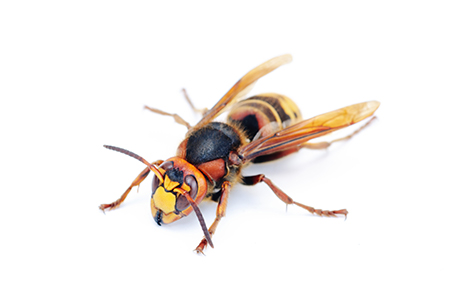
European Hornet
-
European Hornets are 1-2 inches in length
-
They are yellow and black striped with a red tint on their head and thorax
-
Their nests tend to be large paper nests often found in trees
-
They can also build invasive nests (nests built in voids/cavities of your home)
-
European Hornets are the largest hornet found in America
-
They emit an attack pheromone that other hornets will sense and also attack
-
They may sting multiple times and do not die from stinging
European Hornets
-
European Hornets are 1-2 inches in length
-
They are yellow and black striped with a red tint on their head and thorax
-
Their nests tend to be large paper nests often found in trees
-
They can also build invasive nests (nests built in voids/cavities of your home)
-
European Hornets are the largest hornet found in America
-
They emit an attack pheromone that other hornets will sense and also attack
-
They may sting multiple times and do not die from stinging

Honey Bee
-
Honey Bees are yellow/honey colored
-
They can be found in tree cavities but they can also make a home in any structure with some type of cavity or void including your home
-
These bees are social and exist in large communities
-
A queen may lay up to 2,000 eggs a day
-
The Honey Bee is the only bee that dies after stinging
-
The fate of a pupating Honey Bee is decided by what the caretaker bees feed them; “royal jelly” is fed to bees intended to be reproductives
Wasps
-
Honey Bees are yellow/honey colored
-
They can be found in tree cavities but they can also make a home in any structure with some type of cavity or void including your home
-
These bees are social and exist in large communities
-
A queen may lay up to 2,000 eggs a day
-
The Honey Bee is the only bee that dies after stinging
-
The fate of a pupating Honey Bee is decided by what the caretaker bees feed them; “royal jelly” is fed to bees intended to be reproductives
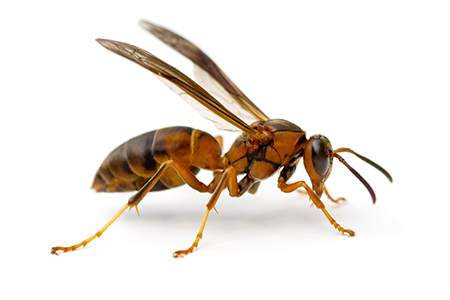
Paper Wasp
-
Wasps can measure from ¾ – 1 inch in length
-
They are black and yellow striped
-
When in flight their legs seem to dangle lower than their body
-
Their nests are open combs
-
Wasps will surround their nest with a chemical to deter insects such as ants from attacking/foraging their nest
-
Wasps can be found on every continent except for Antarctica
-
In the fall all wasps die except for a few new queens that rebuild a colony in the spring after hibernating through the winter
-
They will travel as far as 400 yards (4 football fields) to find food
Paper Wasp
-
Wasps can measure from ¾ – 1 inch in length
-
They are black and yellow striped
-
When in flight their legs seem to dangle lower than their body
-
Their nests are open combs
-
Wasps will surround their nest with a chemical to deter insects such as ants from attacking/foraging their nest
-
Wasps can be found on every continent except for Antarctica
-
In the fall all wasps die except for a few new queens that rebuild a colony in the spring after hibernating through the winter
-
They will travel as far as 400 yards (4 football fields) to find food
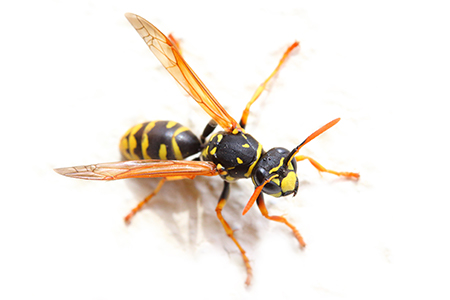
Yellow Jackets
-
Yellow Jackets are typically a ½ inch in length
-
They are bright yellow with thin black stripes
-
Their nests are found in cavities of trees, buildings, and homes but can also create ground nests
-
They enter and exit their nests similar to planes at a very active airport
-
Many other insects mimic Yellow Jackets in color and pattern to scare off predators
-
Underground nests tend to be repurposed animal burrows
-
Never swat at a Yellow Jacket as this will increase your chances of being stung
Yellow Jacket
-
Yellow Jackets are typically a ½ inch in length
-
They are bright yellow with thin black stripes
-
Their nests are found in cavities of trees, buildings, and homes but can also create ground nests
-
They enter and exit their nests similar to planes at a very active airport
-
Many other insects mimic Yellow Jackets in color and pattern to scare off predators
-
Underground nests tend to be repurposed animal burrows
-
Never swat at a Yellow Jacket as this will increase your chances of being stung

White Faced Hornet
- Adult workers tend to measure around ½ inch in length
- Mostly black and covered in white stripes
- Named for their white faces/heads
- Paper nests tend to be large and tear-shaped and are found either in trees or under horizontal surfaces
- Can emit an attack pheromone that other Bald Faced Hornets of the same nest will sense and also attack
- May sting multiple times and do not die from stinging
- All but the queen live for only one season
White Faced Hornet
-
Adult workers tend to measure around ½ inch in length
-
Mostly black and covered in white stripes
-
Named for their white faces/heads
-
Paper nests tend to be large and tear-shaped and are found either in trees or under horizontal surfaces
-
Can emit an attack pheromone that other Bald Faced Hornets of the same nest will sense and also attack
-
May sting multiple times and do not die from stinging
-
All but the queen live for only one season

Carpenter Bee
-
Adult Carpenter Bees can measure ¾ – 1 inch in length
-
They closely resemble bumble bees, but are larger and more robust with the top surface of their abdomen mostly bare and shiny
-
They will drill into wood and create a nearly perfect hole approximately 1/2 inch in diameter, leaving round holes and a coarse sawdust-like substance called frass
-
Carpenter Bees will try to bore into the bare wood near the roof, such as in eaves, gables, fascia board, decking, or other wood areas around the exterior of a home
-
The male Carpenter Bee does not have a stinger, and only hovers around humans as an intimidation method
-
A Carpenter Bee can dig a burrow as far as 4 feet long inside of a wooden structure
carpenter Bee
-
Adult Carpenter Bees can measure ¾ – 1 inch in length
-
They closely resemble bumble bees, but are larger and more robust with the top surface of their abdomen mostly bare and shiny
-
They will drill into wood and create a nearly perfect hole approximately 1/2 inch in diameter, leaving round holes and a coarse sawdust-like substance called frass
-
Carpenter Bees will try to bore into the bare wood near the roof, such as in eaves, gables, fascia board, decking, or other wood areas around the exterior of a home
-
The male Carpenter Bee does not have a stinger, and only hovers around humans as an intimidation method
-
A Carpenter Bee can dig a burrow as far as 4 feet long inside of a wooden structure

European Hornet
-
European Hornets are 1-2 inches in length
-
They are yellow and black striped with a red tint on their head and thorax
-
Their nests tend to be large paper nests often found in trees
-
They can also build invasive nests (nests built in voids/cavities of your home)
-
European Hornets are the largest hornet found in America
-
They emit an attack pheromone that other hornets will sense and also attack
-
They may sting multiple times and do not die from stinging
European Hornets
-
European Hornets are 1-2 inches in length
-
They are yellow and black striped with a red tint on their head and thorax
-
Their nests tend to be large paper nests often found in trees
-
They can also build invasive nests (nests built in voids/cavities of your home)
-
European Hornets are the largest hornet found in America
-
They emit an attack pheromone that other hornets will sense and also attack
-
They may sting multiple times and do not die from stinging

Honey Bee
-
Honey Bees are yellow/honey colored
-
They can be found in tree cavities but they can also make a home in any structure with some type of cavity or void including your home
-
These bees are social and exist in large communities
-
A queen may lay up to 2,000 eggs a day
-
The Honey Bee is the only bee that dies after stinging
-
The fate of a pupating Honey Bee is decided by what the caretaker bees feed them; “royal jelly” is fed to bees intended to be reproductives
Wasps
-
Honey Bees are yellow/honey colored
-
They can be found in tree cavities but they can also make a home in any structure with some type of cavity or void including your home
-
These bees are social and exist in large communities
-
A queen may lay up to 2,000 eggs a day
-
The Honey Bee is the only bee that dies after stinging
-
The fate of a pupating Honey Bee is decided by what the caretaker bees feed them; “royal jelly” is fed to bees intended to be reproductives

Paper Wasp
-
Wasps can measure from ¾ – 1 inch in length
-
They are black and yellow striped
-
When in flight their legs seem to dangle lower than their body
-
Their nests are open combs
-
Wasps will surround their nest with a chemical to deter insects such as ants from attacking/foraging their nest
-
Wasps can be found on every continent except for Antarctica
-
In the fall all wasps die except for a few new queens that rebuild a colony in the spring after hibernating through the winter
-
They will travel as far as 400 yards (4 football fields) to find food
Paper Wasp
-
Wasps can measure from ¾ – 1 inch in length
-
They are black and yellow striped
-
When in flight their legs seem to dangle lower than their body
-
Their nests are open combs
-
Wasps will surround their nest with a chemical to deter insects such as ants from attacking/foraging their nest
-
Wasps can be found on every continent except for Antarctica
-
In the fall all wasps die except for a few new queens that rebuild a colony in the spring after hibernating through the winter
-
They will travel as far as 400 yards (4 football fields) to find food

Yellow Jackets
-
Yellow Jackets are typically a ½ inch in length
-
They are bright yellow with thin black stripes
-
Their nests are found in cavities of trees, buildings, and homes but can also create ground nests
-
They enter and exit their nests similar to planes at a very active airport
-
Many other insects mimic Yellow Jackets in color and pattern to scare off predators
-
Underground nests tend to be repurposed animal burrows
-
Never swat at a Yellow Jacket as this will increase your chances of being stung
Yellow Jacket
-
Yellow Jackets are typically a ½ inch in length
-
They are bright yellow with thin black stripes
-
Their nests are found in cavities of trees, buildings, and homes but can also create ground nests
-
They enter and exit their nests similar to planes at a very active airport
-
Many other insects mimic Yellow Jackets in color and pattern to scare off predators
-
Underground nests tend to be repurposed animal burrows
-
Never swat at a Yellow Jacket as this will increase your chances of being stung
Our Services
One-time spring treatment
All Seasons Pest Control will come to your home or business to do a treatment that will prevent all types of bees, hornets, wasps and yellow jackets from invading your space. If you do encounter a problem, we will come back out and retreat at no cost to you as part of our guarantee.
One-time Nest Treatment/Removal
The nest will be located and treated. If possible, the nest will be removed.
Preventive Services
We offer monthly, seasonal bi-monthly, quarterly, and twice a year preventive services that offer you the maximum protection.
Stop the Infestation Fast Contact Us
Stop the Infestation Fast Contact Us
Preventative Bee Control
If you live in an area that has a high bee population, or perhaps there’s a bee allergy in your family, consider professional bee prevention. The professional exterminators at All Seasons Pest Control now offers bee prevention spraying to help prevent a bee infestation before it even starts!
Bees, Hornets, Wasp and Yellow Jackets Facts
Honey Bees
We all love the sweet nectar that these creatures give us, not to mention their imperative role in the pollination process. What we don’t love so much is sharing a living space with them as they pose the risk of stings! To avoid this situation it is suggested that you make sure to remove and prevent any access to sugars, such as food or drinks, as well as water which can be attractive to honey bees. This includes trash, soda cans, water dishes, and most importantly, flowers which they gravitate towards for pollinating.
If you are already past the point of prevention and they have invaded your space and created a hive, this is where we come in. When you notice one, please contact us today! Attempting to remove a bees nest yourself is extraordinarily difficult, dangerous, and more often than not results in numerous stings or a trip to your local emergency room. Please utilize our online form to schedule an appointment where we can come to you, assess your specific situation and provide you with a free estimate. We can then proceed to remove your hive professionally and ensure that no one (including the bees!) are harmed in the process!
Carpenter Bees
Just like the honey bee, carpenter bees are wonderful for pollination. Unfortunately, they aren’t so wonderful when they make the soft woods of cedar or pine in your home, their own personal living space as well. These little diggers do not feed on the wood or your home, but instead, bore themselves into it where they will either lay eggs or take shelter from the cold. While the one small tunnel may seem small, carpenter bees burrow extensively into what is known as a gallery. They form very complex, considerable, and comprehensive tunnels that span deep into the wood. This can create immense damage to the integral framework in your home and can quickly turn into a huge structural problem. If you think you may have a carpenter bee infestation, check for these warning signs:
- 1/2- to 3/4-inch circular openings in wood
- Sawdust or wood shavings around or near those openings
- A yellow substance near or just inside the entrance
- Threatening flight activity around the area, which is usually males defending the territory
Should you see any of these, do not hesitate to call us now! We want to make sure that they do not cause any further damage to your home and that we quickly exterminate any already present. Please utilize our online form to schedule an appointment where we can come to you, assess your specific situation and provide you with a free estimate. We then will be able to help you safely and efficiently rid your home of any and all carpenter bees as well as provide you with tips for avoiding similar situations in the future.
Wasps
Wasps are not the kindest of creatures and many find this out by unfortunately being stung themselves or seeing someone they love (including pets) be stung. You may have a wasp nest on your property if you regularly see these quick critters flying around, you have a larger number of flies or other insects on your property (as this is what wasps feed on), or you see one of their nests that are made out of what resembles tissue paper like material. These feisty insects construct their nests both above and below ground and can be found in places like in a corner of your home, hanging from trees or poles, or under housing siding.
As mentioned, they do sting so if you continue to see wasps on your property or spot a nest yourself, we recommend that you call All Seasons Pest Control today. You may also choose to fill out our online form to detail your issue or concern. We will be able to schedule an upcoming appointment with you for us to come to your location, assess the situation, and provide you with a free estimate. In most cases, we will be able to provide extermination services on that day as well. Again, please call immediately when you suspect you have a problem because we don’t want anyone being stung!
Yellow Jackets
Yellow jackets, a type of wasp, are another aggressive insect. You can ensure that you have a yellow jacket infestation similarly to how you would with wasps (hint, hint… they are a subset of wasps themselves). You may have a yellow jacket nest on your property if you regularly see these quick critters flying around, you have a larger number of flies or other insects on your property (as this is what yellow jackets feed on), or you see one of their nests that are made out of what resembles tissue paper like material. These feisty insects construct their nests both above and below ground and can be found in places like in a corner of your home, hanging from trees or poles, or under housing siding.
As mentioned, they do sting so if you continue to see wasps on your property or spot a nest yourself, we recommend that you call now. You may also choose to fill out our online form to detail your issue or concern. We will be able to schedule an upcoming appointment with you for us to come to your location, assess the situation, and provide you with a free estimate. In most cases, we will be able to provide extermination services on that day as well. Again, please call immediately when you suspect you have a problem because we don’t want anyone being stung!
White Faced Hornets
White Faced Hornets are a type of yellow jacket, but instead of black markings, they have white. They are oftentimes referred to as Bald faced hornets for this reason as well. Just like yellow jackets, these fiery beings are aggressive and very protective of hives or nests that they have constructed. For this reason, we caution those who believe they may have a white faced hornet nest on their property to be extraordinarily careful and to not approach it themselves.
We urge you to, when you become nervous of a potential white faced hornet problem, give us a call or fill out our online form immediately. We will be able to answer a few initial questions and then set up a time for us to come to your residence and further assess the situation. Once we see what you have going on, we will be able to provide a free estimate, and oftentimes, mitigate any problems all in the same outing. Should you be facing issues with white faced hornets, don’t hesitate to give us a call today!
Schedule an inspection online or call All Seasons Pest Control at 315-548-4427 or schedule a free estimate online! We’re A+ Rated with the Better Business Bureau, trust our professionalism and reliability when it comes to handing your bed-bug infestation.
